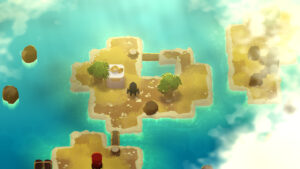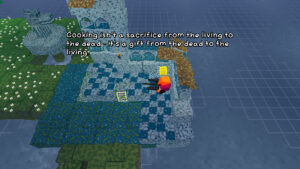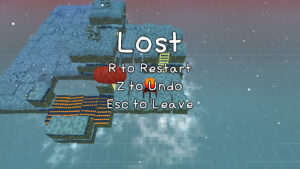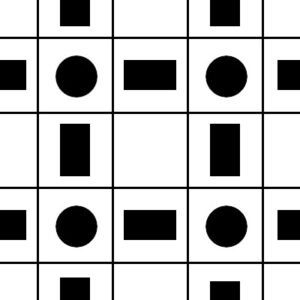 A Monster’s Expedition (Through Puzzling Exhibitions) is a new sort-of-Sokoban-like puzzle game from the creators of Cosmic Express, Sokobond, and, most particularly, A Good Snowman is Hard to Build, which it resembles in a number of ways, starting with the appearance of the player character. Where Snowman had you pushing around large snowballs in the chambers of a hedge maze, Expedition has you push logs around in a network of tiny islands. (The logs start off as trees, but turn into logs when you give them a shove.) The islands and the pushing of cylindrical objects remind me a fair bit of Stephen’s Sausage Roll (which I should get around to finishing sometime), as do the numerous informational plaques. But Expedition is infinitely gentler than SSR, both aesthetically and in terms of difficulty curve.
A Monster’s Expedition (Through Puzzling Exhibitions) is a new sort-of-Sokoban-like puzzle game from the creators of Cosmic Express, Sokobond, and, most particularly, A Good Snowman is Hard to Build, which it resembles in a number of ways, starting with the appearance of the player character. Where Snowman had you pushing around large snowballs in the chambers of a hedge maze, Expedition has you push logs around in a network of tiny islands. (The logs start off as trees, but turn into logs when you give them a shove.) The islands and the pushing of cylindrical objects remind me a fair bit of Stephen’s Sausage Roll (which I should get around to finishing sometime), as do the numerous informational plaques. But Expedition is infinitely gentler than SSR, both aesthetically and in terms of difficulty curve.
One of the key factors in this gentleness is that not every island is a puzzle. The islands all exist in a frankly enormous connected space, impressive when you pan around it in fast travel mode. And some of them are just connections between other islands, ways to control the flow. You get from island to island by pushing logs into the water to make bridges or, sometimes, rafts (about which more later). When you get to an island and all it has is a couple of trees in exactly the right positions to make bridges to other islands, it feels like a respite from puzzling, an easy task as a cushion between the hard tasks.
One thing I’m really liking about it is the elegance of the behaviors. Although the rules are complex enough to produce puzzles, they feel simple because they make sense, visually if not logically. Logs move one space if pushed lengthwise, but roll until they hit an obstacle if pushed from the side. You can stand on a stump and walk onto an adjacent log, but you can’t step onto a log directly unless it’s in the water. If a log is in the water, you can walk along it, but attempting to step off laterally just makes it spin in place. This stuff is very easy to internalize. Similarly, the goals are natural and implicit. You’re not trying to push things to demarcated destinations that arbitrarily make doors open. The way that logs bridge gaps to other islands follows naturally from their behavior.
There’s one moment in particular where I was in awe of the designer’s mastery of their craft. Mild spoilers for the game’s beginning follow.
When two logs fall into the same water space, they spontaneously turn into a raft. This is something you discover early on. You can walk on rafts like logs, but unlike logs, you can step off them in any direction, and this seems like the main thing distinguishing them. You reach an island that has a windmill on it — clearly an important landmark that you want to reach, but the way is blocked by a tree, and you can’t push the tree down because the spot you’d have to stand to push it from is water. With a little cleverness, however, you can use a couple of other trees to make a raft there! And so you stand on the raft, and you push the tree, expecting it to fall, but instead, the force of your push launches the raft, sending it drifting far away into unexplored waters, revealing a larger world. It’s at this point that the game displays the title, effectively telling you that you’ve left the prologue and entered the main part of the game, but more importantly reassuring you that what you just did was right. Even though you were tricked into guessing wrong about what was going to happen, the game isn’t going to punish you. Rather, it’s rewarding you with something better than you expected, because it wants you to keep trying things.
I’ve managed to find my way back to the windmill, but I haven’t finished the game yet. On the basis of precedent (particularly Snowman), I expect that eventually everything will feed into a semi-hidden metapuzzle that makes you re-solve old puzzles in new ways. The thing is, even this follows kind of naturally. Because the goals are implicit, they’re flexible. Sure, most islands are set up so that there’s only one useful thing you can do with the logs. But you inevitably consider other possibilities when you haven’t yet figured out what that one thing is.
 Comments(0)
Comments(0)


